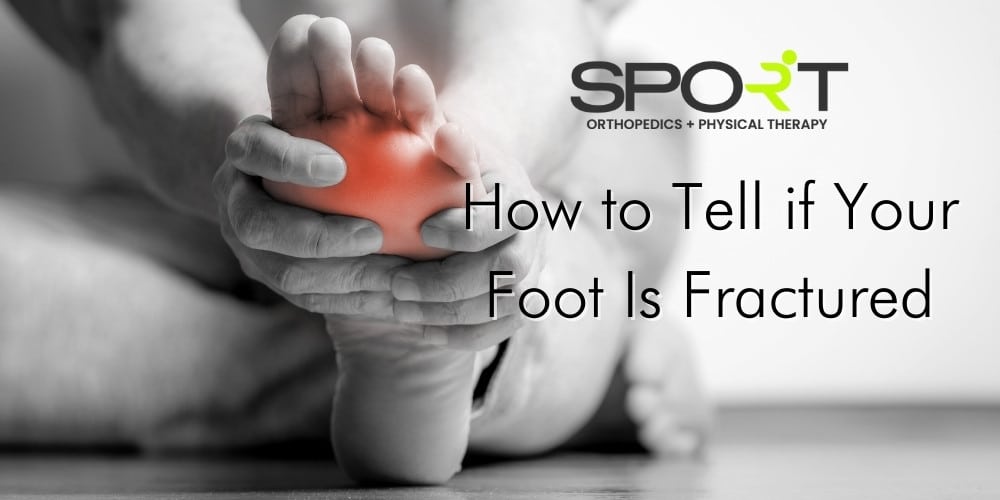Regardless of your job or lifestyle, we use our feet every single day. From walking the dog to moving around the house, they are a vital part of our bodily autonomy and independence. So what happens if your feet become injured? Foot injuries like fractures and sprains are the most common reported injuries in the workplace, according to the Bureau of Labor Statistics, with over 50,000 reported injuries per year. For this reason, our orthopedic specialists have outlined how to tell if your foot is fractured in the following blog.
Foot injuries can cause mild or severe pain, and understanding the different kinds of injuries will make a huge impact on your recovery routine and timeline. If you’re experiencing a foot injury, SPORT Orthopedics + Physical Therapy (469-200-2832) can help.
Difference Between a Fractured vs Broken Bone
It may surprise you that fracture and break are used interchangeably by medical professionals. Both words describe a bone that has either been shattered or severed from the rest of the bone. Both terms can describe a minimal or severe condition. Fracture may be used by medical professionals more often simply because it is more professional sounding. Additionally, there are several different types of fracture classifications doctors use.
For example, a doctor may determine that you have a transverse fracture, which may not mean much to you as the patient. But, it will help your medical team conduct a treatment and recovery plan. For all intents and purposes, if you have a broken foot you will likely be diagnosed with a fracture.
Types of Foot Fractures
There are seven main types of foot fractures. Each type describes a different state of the bone at the time or presentation of the fracture. Knowing these fractures can help you and your medical care provider understand what needs to be done in order to heal.
The seven types of fractures include:
- Transverse fracture: This occurs when the bone is broken at a 90 degree angle to the bone axis. This usually occurs after a blunt force trauma head on to the bone.
- Oblique fracture: This is a fracture that is curved or at an angle to the bone axis. This is typically caused from blunt force trauma above or below the bone axis.
- Open fracture: This is a very serious broken bone, where the bone protrudes out from the skin. If not attended to quickly, an open fracture can cause permanent damage to the skin and bone. This type of fracture is also highly prone to infection because of its external exposure.
- Greenstick fracture: This is where a bone is bent out of shape, but not broken off from the main bone axis. This is most commonly seen in children, whose bones are still soft and flexible.
- Stress fracture: Stress fractures are hairline fissures in the bone that can cause discomfort. They can also lead to more serious breaks if they are continued to be leaned upon. Athletes and people who perform physical labor may often have stress fractures.
- Pathologic fracture: Pathologic fractures occur when the bones are weakened from a condition or disease, and break under minimal strain. For example, someone with osteoporosis, who has decreased bone density, may fracture a bone from lifting something heavy, an activity that would not cause a healthy bone to break.
What Causes Foot Fractures?
There can be several factors that can cause your foot to fracture, both in your workplace and in your everyday life. Because there are so many foot bones, they are more likely to break because they are smaller and therefore more fragile than, say, your arm bone. In fact, there are 26 bones, 33 joints, and over 100 muscles and tendons in one foot alone. While this complex mechanical structure allows us a better range of movement and abilities in our feet, it also leaves us open for more to go wrong.
Common Risk Factors for Foot Fractures
While there are a variety of things that may cause a foot fracture, the following are the most common causes:
- High stress: High stress can mean a lot of things in this content. It can include increased use of the foot, sports activities, or even a lack of supportive footwear. Like any body part, the feet need time to rest and recover in order to prevent excessive strain that makes things like a broken foot more likely.
- Excessive force: Excessive force can also cause a broken foot. For example, dropping a heavy object, experiencing excessive pressure, or even repetitive force in a short period can all create opportunities for a broken foot.
- Fall or twist: Falling on or twisting your foot incorrectly can also lead to a broken foot. Then can happen during sports or other active activities, or while simply walking without being mindful. This can be a heightened risk for seniors or people with disabilities, who may have an already heightened fall risk for a number of reasons.
- Lack of nutrients: Lack of certain nutrients, like calcium and vitamin D, can make a person more susceptible to things like a foot fracture or general foot pain. You can experience nutrient deficiencies from an improper diet, or from certain medical conditions. Supplements and lifestyle changes can be two ways to improve nutrient intake.
- Lack of bone density: Reduced bone density can also lead to a higher chance of broken bones. This is because the bones become more brittle due to reduced minerality. You can experience a reduction of bone density from certain medications or medical conditions, as well as certain nutrient deficiencies. A doctor may prescribe you certain supplements in order to reverse or treat bone density concerns.
This is why it’s so important to take care of our feet with proper treatment. If you do things like wear proper shoes and maintain proper posture, then you’re more likely to reduce your risk of fractures in everyday life. If your life is particularly active, then stretching and practicing foot care are also important steps.
What Is the Difference Between a Fracture and a Sprain?

While fractures and breaks are used interchangeably in the medical community, fractures and sprains actually describe two different conditions. A fracture is when you break bones, while a sprain is a soft tissue injury. It deals more with the ligaments, muscles, and tendons. Both conditions can be incredibly painful, and vary in seriousness.
A minimal sprain, similar to a minimal fracture, may only require rest and ice. While a ligament tear sprain may go as far as requiring surgery to repair. Sprains are caused by overexertion, which is pretty common for the foot and ankle areas. This is why allowing your body time to rest is so important.
Foot Fracture Symptoms
In some severe cases, such as open fractures, a broken foot or bone can be obvious. However, in others, you may not know you even have a broken bone. Be on the lookout for these symptoms:
- Out-of-place or misshapen limb or joint;
- Swelling, bruising, or discoloration;
- Intense pain radiating from the area;
- Numbness and tingling around the area;
- Inability to move or put weight on the area;
- Limited mobility without pain or tenderness.
You may also experience fatigue or fever with a broken bone. If you experience any of these symptoms, seek out a medical care provider so that they can do a bone scan and confirm a fracture diagnosis.
When to See a Doctor for a Foot Fracture
You should always seek out a medical professional if you believe you have a broken bone. If you are someone prone to sprains and fractures because of a medical condition, then reach out to your care team about any emergent symptoms. The only way to 100% diagnose a broken foot is with an x-ray. It’s important to receive a diagnosis so that you can have access to any medication, time off, or accommodations, such as canes or scooters, that you might need to properly heal.
Treatment for Foot Fractures
Depending on the type of fracture, your age, and your lifestyle, the treatment of broken bones will vary. Some broken bones require surgery, while others can be healed with at-home care.
Surgical Treatment
In the case of a severely broken foot, you may need surgery in order to correct it. During foot fracture surgery, you will be put completely under general anesthesia. Then, the surgeon will make an incision above the fracture, realign it as well as possible, and use implants such as pins and screws to brace the bone and ensure proper healing.
Recovery from surgery is likely to take longer than nonsurgical treatment, as your body is recovering from more trauma. In fact, you may not be able to use your foot at all for a few weeks.
Nonsurgical Treatment
Most foot fractures don’t rely on surgery to heal. Instead, a combination of a cast and at-home treatment will suffice. Nonsurgical treatment of a fractured foot includes:
- Rest;
- Alternating ice and heat;
- Physical therapy;
- Gentle stretches;
- Anti-inflammatory medication.
These may all be prescribed by your doctor and should be performed until the foot feels and functions like normal. The standard recovery time for a broken foot is six to eight weeks.
How to Prevent Foot Injuries
It’s important to take steps to prevent injuries before they happen, especially if your work or lifestyle depends on the use of your feet and legs. Taking preventative steps can be easy, and have other benefits for your overall physical health. Some ways to prevent foot injuries include:
- Stretch your feet regularly;
- Warm up before any sports of physical activity;
- Take epsom salt foot baths;
- Replace athletic shoes regularly;
- Wear proper shoes;
- Wear steel toed boots when working with heavy materials.
Other supportive foot and ankle wear such as wraps, braces, and insoles can also help prevent foot injuries and increase overall foot comfort.
What Complications Can Foot Fractures Cause?
If left untreated or overworked, foot fractures can pose complications to your health. Some of these complications can be serious, and even last the rest of your life. These can include:
- Deformation of the bone;
- Arthritis;
- Bone infection;
- Nerve or blood vessel damage.
Whether or not you experience complications from a broken foot will depend on whether you need surgery, receive proper treatment, follow proper physical therapy and recovery protocol, and how long you leave a fracture to its own devices. This is why it’s important to see a primary care physician if you suspect you’ve fractured your foot or ankle.
Contact SPORT Orthopedics + Physical Therapy Today
Toe and forefoot fractures have the potential to cause excruciating pain, and keep you from living your active life. The weight-bearing bones in our feet allow us to do many things, including walking, running, climbing stairs, and so much more. Having a broken foot can really limit what you can do.
That’s why the best Dallas orthopedic surgeons at SPORT are here to offer solutions. Our orthopedic specialists work alongside skilled physical therapists in Dallas to help patients recover from stress fractures, Jones fractures, and so much more. Contact SPORT Orthopedics + Physical Therapy today to get started on keeping your feet happy and healthy. To schedule an appointment, please call our office at 469-200-2832, or schedule online.



